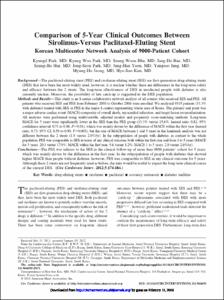KUMEL Repository
1. Journal Papers (연구논문)
1. School of Medicine (의과대학)
Dept. of Internal Medicine (내과학)
Comparison of 5-Year Clinical Outcomes Between Sirolimus-Versus Paclitaxel-Eluting Stent Korean Multicenter Network Analysis of 9000-Patient Cohort
- Keimyung Author(s)
- Hur, Seung Ho
- Department
- Dept. of Internal Medicine (내과학)
- Journal Title
- Circulation: Cardiovascular Interventions
- Issued Date
- 2012
- Volume
- 5
- Issue
- 2
- Abstract
- Background—The paclitaxel-eluting stent (PES) and sirolimus-eluting stent (SES) are first-generation drug-eluting stents (DES) that have been the most widely used; however, it is unclear whether there are differences in the long-term safety and efficacy between the 2 stents. The long-term effectiveness of DES in unselected people with diabetes is also currently unclear. Moreover, the possibility of late catch-up is suggested in the DES population.
Methods and Results—This study is an 8-center collaborative network analysis of all comers who received SES and PES. All patients who received SES and PES from February 2003 to October 2006 were enrolled. We analyzed 9315 patients (33.3% with diabetes) treated with SES or PES in the major 8 centers representing whole area of Korea. The primary end point was a major adverse cardiac event (MACE) composite of overall death, myocardial infarction, and target lesion revascularization. All analyses were performed using multivariable, adjusted models and propensity score-matching methods. Long-term MACE for 5 years were significantly lower in the SES than the PES group (13.3% versus 15.6%; hazard ratio, 0.82; 95% confidence interval, 0.71 to 0.96; P=0.01), which was mainly driven by the difference of MACE within the first year (hazard ratio, 0.73; 95% CI, 0.59 to 0.90; P=0.003), but the rate of MACE between 1 and 5 years in the landmark analysis was not different between the 2 stents (1.9 versus 2.0%/yr). In the subpopulation of people with diabetes, in contrast to the whole population, PES was comparable to SES in terms of any clinical outcome, both within the first year and from 1 to 5 years (MACE for 5 years, 20.3 versus 17.9%; MACE within the first year, 9.6 versus 8.2%; MACE 1 to 5 years, 2.9 versus 2.6%/yr).
Conclusions—The PES was inferior to the SES in the clinical follow-up of more than 9000 patients' cohort for 5 years, which was mainly driven by the difference in the first year. In the subpopulation of people with diabetes that showed higher MACE than people without diabetes, however, PES was comparable to SES in any clinical outcome for 5 years. Although these 2 stents are not frequently used as before, the data would be useful to expect the long-term clinical course of the current DES.
Key Words: drug-eluting stents
sirolimus
paclitaxel
coronary restenosis
diabetes mellitus
- Keimyung Author(s)(Kor)
- 허승호
- Publisher
- School of Medicine
- Citation
- Kyungil Park et al. (2012). Comparison of 5-Year Clinical Outcomes Between Sirolimus-Versus Paclitaxel-Eluting Stent Korean Multicenter Network Analysis of 9000-Patient Cohort. Circulation: Cardiovascular Interventions, 5(2), 174–184. doi: 10.1161/CIRCINTERVENTIONS.111.964650
- Type
- Article
- ISSN
- 1941-7640
- Appears in Collections:
- 1. School of Medicine (의과대학) > Dept. of Internal Medicine (내과학)
- 파일 목록
-
-
Download
 oak-aaa-00946.pdf
기타 데이터 / 2.89 MB / Adobe PDF
oak-aaa-00946.pdf
기타 데이터 / 2.89 MB / Adobe PDF
-
Items in Repository are protected by copyright, with all rights reserved, unless otherwise indicated.